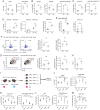GABA signaling enforces intestinal germinal center B cell differentiation
- PMID: 36279432
- PMCID: PMC9636909
- DOI: 10.1073/pnas.2215921119
GABA signaling enforces intestinal germinal center B cell differentiation
Abstract
Recent compelling results indicate possible links between neurotransmitters, intestinal mucosal IgA+ B cell responses, and immunoglobulin A nephropathy (IgAN) pathogenesis. Here, we demonstrated that γ-amino butyric acid (GABA) transporter-2 (GAT-2) deficiency induces intestinal germinal center (GC) B cell differentiation and worsens the symptoms of IgAN in a mouse model. Mechanistically, GAT-2 deficiency enhances GC B cell differentiation through activation of GABA-mammalian target of rapamycin complex 1 (mTORC1) signaling. In addition, IgAN patients have lower GAT-2 expression but higher activation of mTORC1 in blood B cells, and both are correlated with kidney function in IgAN patients. Collectively, this study describes GABA signaling-mediated intestinal mucosal immunity as a previously unstudied pathogenesis mechanism of IgAN and challenges the current paradigms of IgAN.
Keywords: B cells; GABA; IgA; IgAN; germinal center.
Conflict of interest statement
The authors declare no competing interest.
Figures





Similar articles
-
Slc6a13 deficiency promotes Th17 responses during intestinal bacterial infection.Mucosal Immunol. 2019 Mar;12(2):531-544. doi: 10.1038/s41385-018-0111-7. Epub 2018 Dec 6. Mucosal Immunol. 2019. PMID: 30523310
-
The Akt/mTOR/p70S6K pathway is activated in IgA nephropathy and rapamycin may represent a viable treatment option.Exp Mol Pathol. 2015 Dec;99(3):435-40. doi: 10.1016/j.yexmp.2015.08.004. Epub 2015 Aug 19. Exp Mol Pathol. 2015. PMID: 26297427
-
Mammalian target of rapamycin complex 1 signalling is essential for germinal centre reaction.Immunology. 2017 Oct;152(2):276-286. doi: 10.1111/imm.12767. Epub 2017 Jul 10. Immunology. 2017. PMID: 28557002 Free PMC article.
-
Murine Models of Human IgA Nephropathy.Semin Nephrol. 2018 Sep;38(5):513-520. doi: 10.1016/j.semnephrol.2018.05.021. Semin Nephrol. 2018. PMID: 30177023 Review.
-
New insights into the pathogenesis of IgA nephropathy: do toll like receptor 9-B cell activation factor-IgA class switching recombination signaling axis induce IgA hyper-production?Ren Fail. 2014 Jul;36(6):970-3. doi: 10.3109/0886022X.2014.916578. Epub 2014 May 15. Ren Fail. 2014. PMID: 24828398 Review.
Cited by
-
Contemporary insights into neuroimmune interactions across development and aging.Front Neurol. 2025 Jul 25;16:1611124. doi: 10.3389/fneur.2025.1611124. eCollection 2025. Front Neurol. 2025. PMID: 40786636 Free PMC article. Review.
-
Role of FLCN Phosphorylation in Insulin-Mediated mTORC1 Activation and Tumorigenesis.Adv Sci (Weinh). 2023 Jun;10(17):e2206826. doi: 10.1002/advs.202206826. Epub 2023 Apr 21. Adv Sci (Weinh). 2023. PMID: 37083230 Free PMC article.
-
Physiology of γ-aminobutyric acid production by Akkermansia muciniphila.Appl Environ Microbiol. 2024 Jan 24;90(1):e0112123. doi: 10.1128/aem.01121-23. Epub 2023 Dec 13. Appl Environ Microbiol. 2024. PMID: 38088552 Free PMC article.
-
Modulation of alveolar macrophage and mitochondrial fitness by medicinal plant-derived nanovesicles to mitigate acute lung injury and viral pneumonia.J Nanobiotechnology. 2024 Apr 18;22(1):190. doi: 10.1186/s12951-024-02473-w. J Nanobiotechnology. 2024. PMID: 38637808 Free PMC article.
-
Toll-like Receptor Activation Remodels the Polyamine and Tryptophan Metabolism in Porcine Macrophages.Metabolites. 2025 Mar 1;15(3):162. doi: 10.3390/metabo15030162. Metabolites. 2025. PMID: 40137127 Free PMC article.
References
-
- Taylor S., et al. , Phosphatidylethanolamine binding protein-4 (PEBP4) is increased in IgA nephropathy and is associated with IgA-positive B-cells in affected kidneys. J. Autoimmun. 105, 102309 (2019). - PubMed
-
- Floege J., Moura I. C., Daha M. R., New insights into the pathogenesis of IgA nephropathy. Semin. Immunopathol. 36, 431–442 (2014). - PubMed
Publication types
MeSH terms
Substances
LinkOut - more resources
Full Text Sources
Miscellaneous

